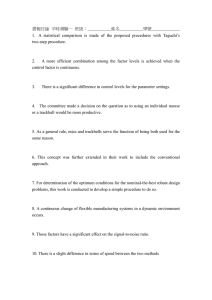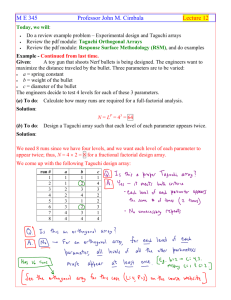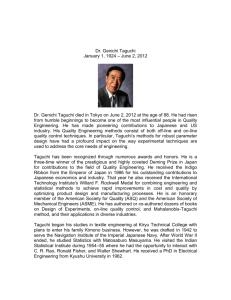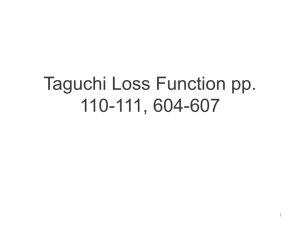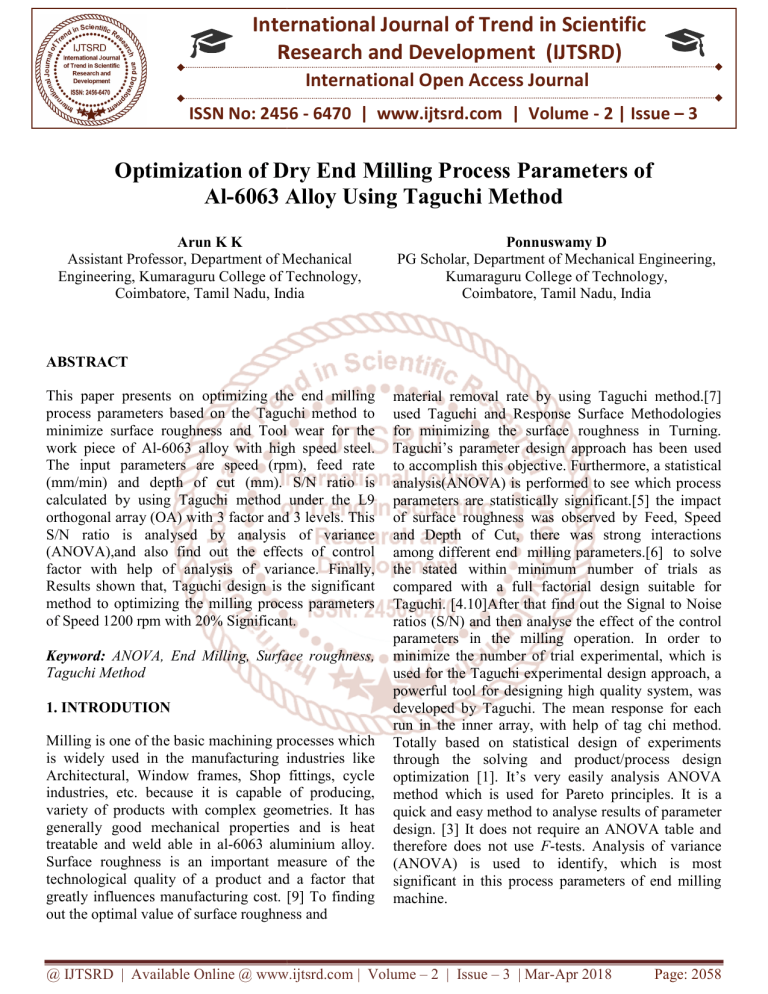
International Journal of Trend in Scientific
Research and Development (IJTSRD)
International Open Access Journal
ISSN No: 2456 - 6470 | www.ijtsrd.com | Volume - 2 | Issue – 3
Optimization of Dry En
End
d Milling Process Parameters of
Al-6063
6063 Alloy Using Taguchi Method
Arun K K
Assistant Professor, Department
tment of Mechanical
Engineering, Kumaraguru College of Technology,
Coimbatore, Tamil Nadu, India
Ponnuswamy D
PG Scholar, Department
tment of Mechanical Engineering,
Engineering
Kumaraguru College of Technology,
Coimbatore, Tamil Nadu, India
ABSTRACT
This paper presents on optimizing the end milling
process parameters based on the Taguchi method to
minimize surface roughness and Tool wear for the
work piece of Al-6063
6063 alloy with high speed steel.
The input parameters are speed (rpm), feed rate
(mm/min) and depth of cut (mm). S/N ratio is
calculated by using Taguchi method under the L9
orthogonal array (OA) with 3 factor and 3 levels. This
S/N ratio is analysed by analysis of variance
(ANOVA),and also find out the effects of control
factor with help of analysis
nalysis of variance. Finally,
Results shown that, Taguchi design is the significant
method to optimizing the milling process parameters
of Speed 1200 rpm with 20% Significant.
Keyword: ANOVA, End Milling, Surface roughness,
Taguchi Method
1. INTRODUTION
Milling is one of the basic machining processes which
is widely used in the manufacturing industries like
Architectural, Window frames, Shop fittings, cycle
industries, etc. because it is capable of producing,
variety of products with complex geometries. It has
generally good mechanical
cal properties and is heat
treatable and weld able in al-6063
6063 aluminium alloy.
Surface roughness is an important measure of the
technological quality of a product and a factor that
greatly influences manufacturing cost. [9] To finding
out the optimal value of surface roughness and
material removal rate by using Taguchi method.[7]
used Taguchi and Response Surface Methodologies
for minimizing the surface roughness in Turning.
Taguchi’s parameter design approach has been used
to accomplish this objective. Furthermore,
Fur
a statistical
analysis(ANOVA) is performed to see which process
parameters are statistically significant.[5] the impact
of surface roughness was observed by Feed, Speed
and Depth of Cut, there was strong interactions
among different end milling parameters.[6]
parameters.
to solve
the stated within minimum number of trials as
compared with a full factorial design suitable for
Taguchi. [4.10]After
After that find out the Signal to Noise
ratios (S/N) and then analyse the effect
ef
of the control
parameters in the milling operation. In order to
minimize the number of trial experimental, which is
used for the Taguchi experimental design approach, a
powerful tool for designing high quality system, was
developed by Taguchi. The mean response for each
run in the inner array, with help of tag chi method.
Totally based on statistical design of experiments
through the solving and product/process
product/
design
optimization [1].
]. It’s very easily analysis ANOVA
method which is used for Pareto principles. It is a
quick and easy method to analyse results of parameter
design. [3] It does not require an ANOVA table and
therefore does not use F-tests.
tests. Analysis of variance
(ANOVA)) is used to identify,
identify which is most
significant in this process parameters of end milling
machine.
@ IJTSRD | Available Online @ www.ijtsrd.com | Volume – 2 | Issue – 3 | Mar-Apr
Apr 2018
Page: 2058
International Journal of Trend in Scientific Research and Development (IJTSRD) ISSN: 2456-6470
2456
2 Methodology
2.1 Experimental set up
The experiments were conducted on a HASS CNC
vertical Milling machining Centre as shown in Figure
2.1(a). The work piece is placed at the centre of the
Machine and held using machine vice.11 GB program
memory, 15" colour
LCD monitor, USB port,
memory lock key switch, rigid tapping and 95
95-gallon
(360 litter) flood coolant system. The cutting tool high
speed steel having four flute 12 mm diameter 75 mm
shank length of the End mill cutter has been used for
experiments.
ts. The dimensions of the work piece
specimen were taken as 50 mm × 50 mm and 16 mm.
As per experimental design were conducted L9 OA
with help of Three control factor and three levels to
assign the experimental date value. Fig 1 Show that
Experimental setupp for end milling machining
process.
Table 1: End Milling Machining Parameters and
levels
Symbol Parameters Level-1
Level
Speed
1300
0
A
(rpm)
Feed
65
B
(mm/min)
Depth
of 0.2
C
cut(mm)
Level-2
1650
Level-3
2000
95
125
0.4
0.6
2.2 Selection of Material
In recent trend,, most of the application using the
aluminium 6063 alloy because of less weight ration
and also good mechanical properties.
properties This material is
heated in Lower temperature it will melted and easily
to manufacturing and time consumption is very less
obtain. The work piece of Al--6063 alloy dimension is
50 mm × 50 mm and 16 mm. chemical composition
are show in table 2.
Table 2 chemical composition
Mn Cu Mg Zi
Cr Si Fe
Othe Al %
%
%
%
%
%
% %
rs
0.10 0.10 0.45 0.10 0.10 0.2 0.35 0.15 Balan
ce
S NO
z
Fig 1 Experimental set up for end milling process
1
2
3
4
5
6
7
8
9
Table
able 3 Measured Ra and
Speed
Feed
Depth of
(rpm)
(mm/min)
(mm/min cut (mm)
1300
65
0.2
1300
95
0.4
1300
125
0.6
1650
65
0.4
1650
95
0.6
1650
125
0.2
2000
65
0.6
2000
95
0.2
2000
125
0.4
Ra
(µm)
0.207
0.169
0.153
0.245
0.252
0.27
0.331
0.479
0.415
3 Results and analysis
3.1Taguchi Method
Fig 2 Surface Roughness Tester mitutoyo (model)
This method uses a special design of orthogonal
arrays to study the entire parameter space with a
minimum number of experiments. Minitab 18
software was used for optimization and graphical
analysis of experimental data. In the framework of
Taguchi method L18 (OA) has been used in order to
explore the process interrelationships
nterrelationships within the
experimental frame the OA has
ha 3 columns and 18
@ IJTSRD | Available Online @ www.ijtsrd.com | Volume – 2 | Issue – 3 | Mar-Apr
Apr 2018
Page: 2059
International Journal of Trend in Scientific Research and Development (IJTSRD) ISSN: 2456-6470
rows. The OA follows a random run order. The run
order is a completely random ordering of the
experiments which is followed when running the
experiments so that experimental error is reduced as
far as possible. Taguchi recommends analysing the
mean response for each run in the inner array and also
suggest to analyse variation using an appropriately
selected signal to noise ratio (S/N). There are three
signals to noise ratios
−10 *log (Σ(Y2)/n))
Smaller the better
……………1
S/NSB
Larger the better
………........2
S/NLB = −10 *log (Σ(1/Y2)/n)
Nominal-the-better
…………… 3
=
S/NNB = −10 *log (Y2)
S/N= signal to noise ratio. yi= observed value of the
experiment test. n = number of observation in a trials.
The Taguchi technique is approach a experimental
style technique, which is helpful in reducing the
quantity of experiments by various victimisation
orthogonal arrays and additionally tries to reduce
effects of the factors out of management. The basic
philosophy of the Taguchi technique is to confirm
quality in the style part the best approach of the
Taguchi technique area unit to decrease the
experimental time, to reduce the price and to search
out vital factors in a very shorter period. [12] The
most reliable of Taguchi’s techniques is that the use
of parameter style, that is AN engineering technique
for product or method style that focuses on
determinative the parameter (factor) settings
manufacturing the simplest levels of a high quality
characteristic (performance measure) with minimum
variation. the general aim of quality engineering is to
form periodical set, that relation to all noise factors.
the foremost necessary stage within the style of
orthogonal array experiment lies within the choice of
control factors. As many factors as potential ought to
be enclosed so as to that would be potential to spot
non-significant variables at the earliest opportunity
[4,8]. Taguchi creates a typical orthogonal array to
accommodate this demand. Taguchi used the
quantitative relation(S/N) ratio because the quality
characteristic of choice. S/N quantitative relation is
employed as a measurable worth instead of standard
deviation as a result of because the mean decreases,
the standard deviation compared decreases and
contrariwise. Taguchi has through empirical
observation found that the 2 stage optimisation
procedure involving S/N ratios so provides the
parameter level combination, wherever the quality
deviation is minimum whereas keeping the mean not
off course.
Table 4 measured S/N ratio for Ra
S No
Ra
TW
SNRA1 SNRA2
(µm)
(mm)
1
0.207 0.038
13.681 28.404
2
0.169 0.031
15.442 30.173
3
0.153 0.053
16.306 25.514
4
0.245 0.077
12.217 22.270
5
0.252 0.044
11.972 27.131
6
0.27
0.042
11.373 27.535
7
0.331 0.094
9.603
20.537
8
0.479 0.114
6.393
18.862
9
0.415 0.13
7.639
17.721
3.2 Conceptual S/N ratio approach
Taguchi recommends analysing the effect of the S/N
ratio magnitude relation using abstract approach that
involves graphing the consequences and visually
characteristic the factors that seem to be important
factor, without victimization ANOVA, therefore
creating the analysis simple approach. In this S/N
ratio, Smaller - the better characterises is used to
identify the surface roughness (Ra) at that same
Larger-the better is used to identify the material
removal rate. In signal to noise ratio is one of the
main cretin factor during machining time because of
noise will comes from various factors and affect the
quality of surface roughness and decrease the material
removal rate.
Table 8 Analysis of Variance for S/N ratio of Ra
Source
DF
Adj SS
Speed
(rpm)
2
79.3930
Feed
(mm/mi
n)
2
Depth of 2
cut
(mm)
2
Error
Total
8
Adj
MS
39.696
5
FPValue Value
48.70 0.020
0.5757
0.2879
0.35
0.739
6.9908
3.4954
4.29
0.189
1.6303
0.8152
88.5899
@ IJTSRD | Available Online @ www.ijtsrd.com | Volume – 2 | Issue – 3 | Mar-Apr 2018
Page: 2060
International Journal of Trend in Scientific Research and Development (IJTSRD) ISSN: 2456-6470
optimal level for the control factors was end milling
machining of Speed 1200 rpm with feed rate 65
mm/min and Depth of cut 0.6 mm. Compared with the
experimental values, the optimal Surface roughness of
the 9 confirmation sample is 0.150 µm which very
close to the optimal value of surface roughness 0.157
µm.
Main Effects Plot for SN ratios Ra
Data Means
Speed (rpm)
16
Feed (mm/min)
Depth of cut (mm)
Mean of SN ratios
15
14
13
12
11
10
9
8
References
7
1 300
1 650
2000
65
95
1 25
0.2
0.4
0.6
Signal-to-noise: Smaller is better
1) Anyılmaz, M. S. (2006). Design of experiment
and an application for Taguchi method in quality
improvement activity(Doctoral dissertation, MS
Thesis, Dumlupınar University, Turkey).
Fig 3 show that S/N ratio of Ra value
Residual Plots for S/N ratio of Ra values
Normal Probability Plot
Versus Fits
99
0.50
Residual
Percent
90
50
10
1
0.00
-0.25
-0.50
-1 .0
-0.5
0.0
0.5
1 .0
5.0
7.5
Residual
Histogram
1 2.5
1 5.0
Versus Order
0.50
Residual
Frequency
1 0.0
Fitted Value
3
2
1
0
2) Aslan, Ersan, Necip Camuşcu, and Burak
Birgören. "Design optimization of cutting
parameters when turning hardened AISI 4140
steel (63 HRC) with Al2O3+ TiCN mixed ceramic
tool." Materials & design 28.5 (2007): 1618-1622.
0.25
0.25
0.00
-0.25
-0.50
-0.6
-0.4
-0.2
0.0
Residual
0.2
0.4
0.6
1
2
3
4
5
6
7
8
9
Observation Order
Fig 4 Show that Residual plot for Ra
Fig 4 show that , A residual plot is a graph that is
used to examine the goodness-of-fit in ANOVA
analysis of variation. This residual plots is to
determine whether the ordinary least squares
assumptions are being met or not. If these
assumptions are satisfied, then ordinary least squares
regression will produce unbiased coefficient estimates
with the minimum variance.
Histogram to determine whether the data are skewed
or whether outliers exist in the data.
Normal probability plot of residuals to verify the
assumption that the residuals are normally distributed
Residuals versus fits to verify the assumption that the
residuals have a constant variance.
Residuals versus order of data to verify the
assumption that the residuals are uncorrelated with
each other.
Conclusion
The conclusions derived from optimizing machining
parameters and approach in end milling Al-6063
material are as follows. Experiments are performed
based on L9 OA chosen from Taguchi’s Method and
analysis is done using analysis of variation for
optimizing multiple performance characteristics. The
3) Bhattacharya, Anirban, et al. "Estimating the
effect of cutting parameters on surface finish and
power consumption during high speed machining
of AISI 1045 steel using Taguchi design and
ANOVA." Production Engineering 3.1 (2009):
31-40.
4) Hassan, Kamal, Anish Kumar, and M. P. Garg.
"Experimental investigation of Material removal
rate
in
CNC
turning
using
Taguchi
method." International Journal of Engineering
Research and Applications 2.2 (2012): 1581-1590.
5) Kaladhar, M., et al. "Application of Taguchi
approach and Utility Concept in solving the Multiobjective Problem when turning AISI 202
Austenitic
Stainless
Steel." Journal
of
Engineering Science & Technology Review 4.1
(2011).
6) Kim, Hong Seok. "A combined FEA and design
of experiments approach for the design and
analysis of warm forming of aluminum sheet
alloys." The International Journal of Advanced
Manufacturing Technology 51.1-4 (2010): 1-14.
7) Kolahan, Farhad, Mohsen Manoochehri, and
Abbas Hosseini. "Simultaneous optimization of
machining parameters and tool geometry
specifications in turning operation of AISI1045
steel." World academy of science, Engineering
and Technology 74 (2011): 786-789.
8) Mariajayaprakash, A., & Senthilvelan, T. (2012).
Process parameter optimization of grate (sugar
@ IJTSRD | Available Online @ www.ijtsrd.com | Volume – 2 | Issue – 3 | Mar-Apr 2018
Page: 2061
International Journal of Trend in Scientific Research and Development (IJTSRD) ISSN: 2456-6470
mill boiler) through failure mode and effect
analysis and Taguchi method. In Proceedings of
International Conference on Advances in
Industrial and Production Engineering, AMAE,
Bangalore.
9) Nalbant, M., H. Gökkaya, and G. Sur.
"Application of Taguchi method in the
optimization of cutting parameters for surface
roughness in turning." Materials & design 28.4
(2007): 1379-1385.
10) Thamizhmanii, S., S. Saparudin, and S. Hasan.
"Analyses of surface roughness by turning process
using Taguchi method." Journal of Achievements
in
Materials
and
Manufacturing
Engineering 20.1-2 (2007): 503-506.
11) Sankar, R. Siva, et al. "Selection of machining
parameters for constrained machining problem
using
evolutionary
computation." The
International Journal of Advanced Manufacturing
Technology 32.9-10 (2007): 892-901.
12) Shetty, Raviraj, et al. "Study on surface roughness
minimization in turning of DRACs using surface
roughness methodology and Taguchi under
pressured steam jet approach." ARPN Journal of
Engineering and Applied Sciences 3.1 (2008): 5967.
@ IJTSRD | Available Online @ www.ijtsrd.com | Volume – 2 | Issue – 3 | Mar-Apr 2018
Page: 2062

